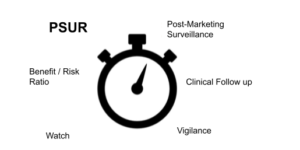PSUR: Periodic Safety Update Report for Medical Devices

The Periodic Safety Update Report for medical devices (PSUR) is a periodic report required by the Medical Device Regulation for all devices of Class IIa and above.
It compiles information relating to the security and performance of the device, identified during the Post Market Surveillance activities.
The PSUR is written at the end of the PMS period, two years in class IIa, one year in class IIb, it transcribes your current knowledge of your device and its use, in the current context. For Class III MDs and implantable devices the PSUR is communicated to the Notified Nody (NB) via Eudamed, in all cases it is considered during the evaluations by your NB.
The Periodic Safety Update Report in the Medical Devices Regulation (MDR)
The MD world is not used to PSURs, it is a new feature of the MDR stated in Article 86 :
Manufacturers of class IIa, class IIb and class III devices shall prepare a periodic safety update report (PSUR) for each device and where relevant for each category or group of devices summarising the results and conclusions of the analyses of the post-market surveillance data gathered as a result of the post-market surveillance plan referred to in Article 84 together with a rationale and description of any preventive and corrective actions taken.
The PSUR summarizes the outcome of the post-marketing surveillance activities, setting out conclusions on the indicators followed and on the significant events found. These events may be already identified and already followed up, they may also be new: new risks, or benefits ultimately not achieved.
The surveillance objectives depend on the results of design & development, of risk management and clinical evaluation activities, the PSUR thus aims to demonstrate that the benefit/risk ratio remains favorable during market phase.
State of the art
The state-of-the-art remains succinct in the medical device sector, it is more extensive in pharma:
- MEDDEV 2.12/2 – Post-market clinical Follow-up studies;
- GVP Module VII – PSUR;
- GVP Module IX – Signal Management;
- ICH E2C(R2) – Periodic B/R Report evaluation.
Regarding Regulation (EU) 2017/745, a guide and template, still at the draft stage, are proposed by MDCG:
Contents of the PSUR
General information
The PSUR should be self-supporting and therefore contain the information necessary to understand the context :
- Identification and contact of the manufacturer / authorized representative.
- Identification and general information about the device (or group, or category) and its intended use, including indications and patient profiles.
- Information on the quantity of devices sold and in service, number of users, frequency of use… this is crucial to be able to estimate the probability of risks occurring.
- Information on the period of surveillance that has elapsed: start date, end date and justification for the surveillance period (longer or shorter depending on the risks and uncertainties).
History of changes
All changes that may impact security or performance, relating to the device, an accessory, the information provided, or the intended use are summarized and justified.
These changes may also relate to the technical documentation: any significant changes to the risk analysis or clinical evaluation, not already discussed in the report, should be explained.
Surveillance results (including clinical follow-up)
The PSUR takes up the main objectives defined in the PMS, details their achievement and the results obtained.
The Post-Market Clinical Follow-up (PMCF) is also taken into account, detailing the results and status of ongoing clinical studies, as defined in the PMCF plan and the clinical development plan. Data confirming (or not) the claimed benefits are detailed.
The actions (CAPAs) impacting security or performance implemented during the PMS period are summarized, justified and the results outlined.
New information regarding security, e.g. from watch on equivalent devices or from literature follow-up, is summarized and its consideration is identified, justified if not.
Vigilance results
Alerts, incidents serious and non-serious, adverse reactions, withdrawals… are summarized and estimated (number, frequency of occurrence, health effects), the actions (including FSCAs) implemented are explained.
The impact on the risk analysis is summarized, specifying the risks already identified, and the new risks detected during incidents.
Trend analysis
Any trends, detected in PMS or vigilance, are presented as well as the conclusions drawn and actions decided.
The trends mainly concern the probability of occurrence and severity of residual risks, when they occur sufficiently often to allow this analysis. The idea is to detect a possible increase, to launch adequate preventive actions, or a decrease, sign of the effectiveness of the control of the risks.
Trends can also be regional, especially if there are discrepancies between the EU and other regulatory areas.
Identification and verification of signals
According to good pharmacovigilance practices, a signal is a
Information arising from one or multiple sources, including observations and experiments, which suggests a new potentially causal association, or a new aspect of a known association between an intervention and an event or set of related events, either adverse or beneficial, that is judged to be of sufficient likelihood to justify verificatory action.
It is therefore a matter of detecting and verifying the relevance of new information or patterns (unfolding of events) observed in the field and likely to affect the benefit/risk ratio. (example: a signal relating to an intended out-of-field use that remains to be confirmed).
Benefit/risk analysis
New risks are identified and estimated, modified (or unmet) risks and benefits are re-estimated, the acceptability of the benefit/risk ratio is reassessed.
A statement is made as to the evolution of the B/R ratio since the previous surveillance period.
PSUR conclusion
The PSUR conclusion summarizes the impacts on the estimation of key risks and benefits (which impact the benefit/risk ratio) as well as any emerging risks and any changes in the context, particularly in relation to use of the device.
The remaining uncertainties are outlined.
The actions decided at the end of the PMS period are listed, the planning of the next surveillance will take into account the PSUR findings.
